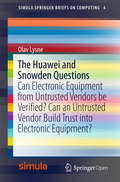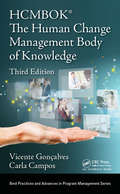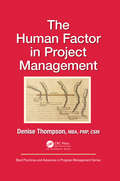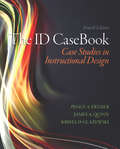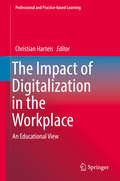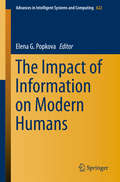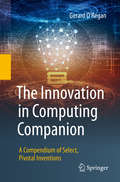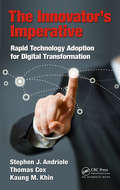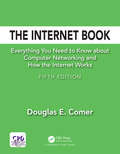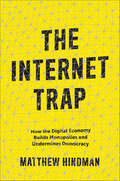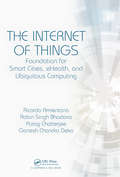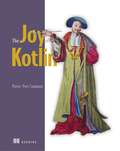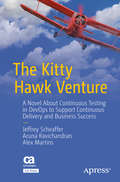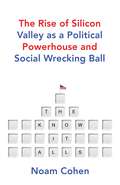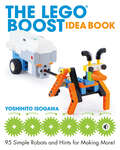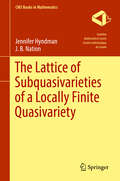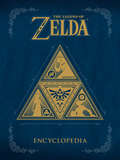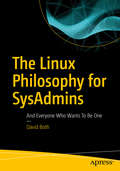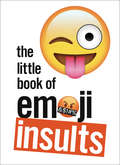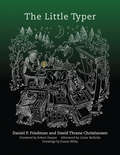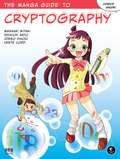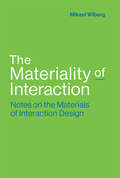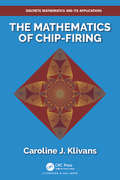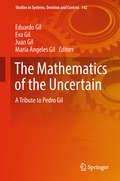- Table View
- List View
The Huawei and Snowden Questions
by Olav LysneThis open access book answers two central questions: firstly, is it at all possible to verify electronic equipment procured from untrusted vendors? Secondly, can I build trust into my products in such a way that I support verification by untrusting customers? In separate chapters the book takes readers through the state of the art in fields of computer science that can shed light on these questions. In a concluding chapter it discusses realistic ways forward. In discussions on cyber security, there is a tacit assumption that the manufacturer of equipment will collaborate with the user of the equipment to stop third-party wrongdoers. The Snowden files and recent deliberations on the use of Chinese equipment in the critical infrastructures of western countries have changed this. The discourse in both cases revolves around what malevolent manufacturers can do to harm their own customers, and the importance of the matter is on par with questions of national security.This book is of great interest to ICT and security professionals who need a clear understanding of the two questions posed in the subtitle, and to decision-makers in industry, national bodies and nation states.
The Human Change Management Body of Knowledge (Best Practices in Portfolio, Program, and Project Management)
by Vicente Goncalves Carla Campos"I am happy to recommend this work. I believe in the principles presented in it and identify with its context. Due to the lack of knowledge on the subject in the market, it is a topic that must be made known. The book should be in the library of all project and change managers."— Paul Dinsmore, PMI Fellow "Every manager should integrate HCMBOK® practices into their project management methodology in order to fully develop their work. This book addresses a simple and practical way that the critical component in organizational change management can be applied to projects of all kinds: the human factor."— Bruno Machado, Director, Project Management Office, Grupo Anima Educação "We live in a time of change, speed, and an avalanche of information. It is still very difficult for most companies to change their organizational culture efficiently. This book makes us reflect upon the crucial element in any change, and which most managers do not place in the foreground—the people." — Joyce Meyer, CEO, iDigo "In today's constantly changing world, the Project Manager must have sensitivity to how people react to change. Knowing a method that provides a structured way to take care of the human aspect is a key factor in the success of any project! HCMBOK® offers a simple and practical approach to managing change, which can be easily incorporated into the project management routine, providing amazing results."— Pedro Augusto Cardoso da Silva, Engineering Director, METRÔRIO This reference starts by presenting the concept of change management, its players, strategies, and applicable models. In the second part, the book covers the set of good practices, methodology, and tools known as the HCMBOK®— Human Change Management Body of Knowledge. The third part introduces the concept of the Change Management Office (CMO) and its relation to the strategic planning of an organization. The book concludes with the competencies essential for a change manager, an approach to agile methodologies, and a model for managing cultural change.
The Human Factor in Project Management (Best Practices in Portfolio, Program, and Project Management)
by Denise ThompsonIn the fluid world of changing business environments and variables affecting projects, a style of project management that primarily relies on maintaining the Iron Triangle, that tenuous mix of schedule, scope, and budgets, is no longer the sole path to success. Today’s project management demands a focus on leadership of the kind that anticipates and embraces change, challenges the status quo, and inspires teams. Developing these skills requires a mastery of emotional intelligence, courage, critical thinking, and a desire to become a true leader dedicated to developing success. Whether you are participating in a project for the first time or you’ve been doing projects for decades, you know the very essence of a project is to return value that gains a competitive edge and propels the organization forward into new frontiers. Whether you believe the best results are earned through agile, waterfall, or a mix of methodologies, project leadership is the secret weapon that will maintain and grow professional relevance, knowledge, and value in today’s workforce. Through a series of notable lessons in human history and behavior, The Human Factor in Project Management takes you on a journey of self-discovery to define your capabilities and gaps, while building your leadership skills. In your role as a project manager, project sponsor, product owner, or champion, the book challenges you to question the choices you make in a series of stories where you are the main character. This guide to career and personal growth forces you to look beyond the limitations of a Gantt chart, spreadsheet, or a Kanban board to evaluate the value from every tool you use and every action you take.
The ID CaseBook: Case Studies in Instructional Design
by Peggy A. Ertmer James A. Quinn Krista D. GlazewskiFirst Published in 2017. Routledge is an imprint of Taylor & Francis, an Informa company.The Fourth Edition of this highly regarded problem-solving text presents 30 realistic case studies in a wide range of authentic contexts, from K-12 to post-secondary, corporate, and manufacturing. The cases and their accompanying discussion questions encourage ID students to analyze the available information, develop conclusions, and consider alternative possibilities in resolving ID problems.
The Impact of Digitalization in the Workplace: An Educational View (Professional and Practice-based Learning #21)
by Christian HarteisThis edited volume brings together researchers from various disciplines (i.e. education, psychology, sociology, economy, information technology, engineering) discussing elementary changes at workplaces occurring through digitalization, and reflecting on educational challenges for individuals, organizations, and society. The latest developments in information and communication technology seem to open new potential, and the crucial question arises which kind of work can be replaced by technology? The contributors to this volume are scholars who have been conducting research on the influence of technological change on work and individuals for a long time. The book addresses researchers as well as practitioners in the field of adult education and human resource development.
The Impact of Information on Modern Humans (Advances In Intelligent Systems And Computing #622)
by Elena G. PopkovaThis book features contributions from various spheres of socio-humanitarian sciences presented at the scientific and practical conference on “Humans as an Object of Study by Modern Science,” which took place in Nizhny Novgorod (Russian Federation) on November 23–24, 2017. The conference was organized by Kozma Minin Nizhny Novgorod State Pedagogical University and the non-profit organization “Institute of Scientific Communications.” Presenting the results of multidisciplinary studies as well as new approaches, the target audience of the book includes postgraduates, lecturers at higher educational establishments, and researchers studying socio-humanitarian sciences. The complex study of humans by representatives of various socio-humanitarian sciences (philosophy, pedagogics, jurisprudence, social sciences, and economics) allows a comprehensive concept of the field to be developed. Selecting humans as an object of research opens wide possibilities for studying various issues related to their activities, while considering humans within multiple sciences means that the methods of induction and deduction can be combined to achieve precise results. This book includes the results of leading scientific studies on the following key issues: establishment of an information economy under the influence of scientific and technical progress: new challenges and opportunities; information and communication technologies as a new vector of development of the modern world economy; specifics and experience of using new information and communication technologies in developed and developing countries; problems of implementing new information and communication technologies in the modern economy; and priorities of using new information and communication technologies in the modern economy.
The Innovation in Computing Companion: A Compendium of Select, Pivotal Inventions
by Gerard O’ReganThis encyclopedic reference provides a concise and engaging overview of the groundbreaking inventions and conceptual innovations that have shaped the field of computing, and the technology that runs the modern world. Each alphabetically-ordered entry presents a brief account of a pivotal innovation and the great minds behind it, selected from a wide range of diverse topics.Topics and features:Describes the development of Babbage’s computing machines, Leibniz’s binary arithmetic, Boole’s symbolic logic, and Von Neumann architectureReviews a range of historical analog and digital computers, significant mainframes and minicomputers, and pioneering home and personal computersDiscusses a selection of programming languages and operating systems, along with key concepts in software engineering and commercial computingExamines the invention of the transistor, the integrated circuit, and the microprocessorRelates the history of such developments in personal computing as the mouse, the GUI, Atari video games, and Microsoft OfficeSurveys innovations in communications, covering mobile phones, WiFi, the Internet and World Wide Web, e-commerce, smartphones, social media, and GPSPresents coverage of topics on artificial intelligence, the ATM, digital photography and digital music, robotics, and WikipediaContains self-test quizzes and a helpful glossaryThis enjoyable compendium will appeal to the general reader curious about the intellectual milestones that led to the digital age, as well as to the student of computer science seeking a primer on the history of their field.Dr. Gerard O'Regan is a CMMI software process improvement consultant with research interests including software quality and software process improvement, mathematical approaches to software quality, and the history of computing. He is the author of such Springer titles as World of Computing, Concise Guide to Formal Methods, Concise Guide to Software Engineering, and Guide to Discrete Mathematics.
The Innovator’s Imperative: Rapid Technology Adoption for Digital Transformation
by Stephen J Andriole Thomas Cox Kaung M. KhinThe pace of technological change is accelerating, hyper competition is growing, opportunities for business model disruption are exploding, and comprehensive cloud delivery is readily available. These factors challenge every aspect of business technology strategy. The Innovator’s Imperative: Rapid Technology Adoption for Digital Transformation prepares twenty-first century businesses leaders for competing and leading in this disruptive digital environment. Five years of research conducted by the authors suggests that leading companies have all but abandoned the requirements analysis and modeling best practices of the twentieth century. Accordingly, the authors put forth the innovator’s imperative that contends: All companies wanting to be competitive should adopt emerging and disruptive technologies as quickly as possible, and in many cases, immediately. Technology is driving business strategy, and companies are rethinking their technology strategy, especially the governance that determines how and why technology investments are made. Based on their research the authors have developed a five-step framework for digital transformation: Model and simulate Identify high-leverage opportunities Prioritize transformational targets Identify digital opportunities Find courageous leaders The book explains each of these steps to guide business leaders in architecting digital transformation projects according to their organization’s market positions, budgets, objectives, and corporate culture. Hyper-competitive, disruptive companies are jumping across technology adoption phases without regard to any phasing whatsoever. Companies focused on digital transformation often adopt emerging technologies immediately. They have become early adopters of technologies that can impact existing—and create whole new—business models and processes. This book examines this jump into new technologies, processes, and business models to prepare twenty-first century business leaders to make that leap.
The Internet Book: Everything You Need to Know about Computer Networking and How the Internet Works
by Douglas E. ComerThe Internet Book, Fifth Edition explains how computers communicate, what the Internet is, how the Internet works, and what services the Internet offers. It is designed for readers who do not have a strong technical background — early chapters clearly explain the terminology and concepts needed to understand all the services. It helps the reader to understand the technology behind the Internet, appreciate how the Internet can be used, and discover why people find it so exciting. In addition, it explains the origins of the Internet and shows the reader how rapidly it has grown. It also provides information on how to avoid scams and exaggerated marketing claims. <P><P>The first section of the book introduces communication system concepts and terminology. The second section reviews the history of the Internet and its incredible growth. It documents the rate at which the digital revolution occurred, and provides background that will help readers appreciate the significance of the underlying design. The third section describes basic Internet technology and capabilities. It examines how Internet hardware is organized and how software provides communication. This section provides the foundation for later chapters, and will help readers ask good questions and make better decisions when salespeople offer Internet products and services. The final section describes application services currently available on the Internet. For each service, the book explains both what the service offers and how the service works. <P><P>About the Author <P><P>Dr. Douglas Comer is a Distinguished Professor at Purdue University in the departments of Computer Science and Electrical and Computer Engineering. He has created and enjoys teaching undergraduate and graduate courses on computer networks and Internets, operating systems, computer architecture, and computer software. One of the researchers who contributed to the Internet as it was being formed in the late 1970s and 1980s, he has served as a member of the Internet Architecture Board, the group responsible for guiding the Internet’s development. Prof. Comer is an internationally recognized expert on computer networking, the TCP/IP protocols, and the Internet, who presents lectures to a wide range of audiences. In addition to research articles, he has written a series of textbooks that describe the technical details of the Internet. Prof. Comer’s books have been translated into many languages, and are used in industry as well as computer science, engineering, and business departments around the world. Prof. Comer joined the Internet project in the late 1970s, and has had a high-speed Internet connection to his home since 1981. He wrote this book as a response to everyone who has asked him for an explanation of the Internet that is both technically correct and easily understood by anyone. An Internet enthusiast, Comer displays INTRNET on the license plate of his car.
The Internet Trap: How the Digital Economy Builds Monopolies and Undermines Democracy
by Matthew HindmanA book that challenges everything you thought you knew about the online economyThe internet was supposed to fragment audiences and make media monopolies impossible. Instead, behemoths like Google and Facebook now dominate the time we spend online—and grab all the profits from the attention economy. The Internet Trap explains how this happened. This provocative and timely book sheds light on the stunning rise of the digital giants and the online struggles of nearly everyone else—and reveals what small players can do to survive in a game that is rigged against them.Matthew Hindman shows how seemingly tiny advantages in attracting users can snowball over time. The internet has not reduced the cost of reaching audiences—it has merely shifted who pays and how. Challenging some of the most enduring myths of digital life, Hindman explains why the internet is not the postindustrial technology that has been sold to the public, how it has become mathematically impossible for grad students in a garage to beat Google, and why net neutrality alone is no guarantee of an open internet. He also explains why the challenges for local digital news outlets and other small players are worse than they appear and demonstrates what it really takes to grow a digital audience and stay alive in today’s online economy.The Internet Trap shows why, even on the internet, there is still no such thing as a free audience.
The Internet of Things: Foundation for Smart Cities, eHealth, and Ubiquitous Computing (Advances In Information Security, Privacy, And Ethics Ser.)
by Ricardo Armentano, Robin Singh Bhadoria, Parag Chatterjee and Ganesh Chandra DekaThis book provides a dual perspective on the Internet of Things and ubiquitous computing, along with their applications in healthcare and smart cities. It also covers other interdisciplinary aspects of the Internet of Things like big data, embedded Systems and wireless Sensor Networks. Detailed coverage of the underlying architecture, framework, and state-of the art methodologies form the core of the book.
The Joy of Kotlin
by Pierre-Yves SaumontSummaryMaintaining poor legacy code, interpreting cryptic comments, and writing the same boilerplate over and over can suck the joy out of your life as a Java developer. Fear not! There's hope! Kotlin is an elegant JVM language with modern features and easy integration with Java. The Joy of Kotlin teaches you practical techniques to improve abstraction and design, to write comprehensible code, and to build maintainable bug-free applications.Purchase of the print book includes a free eBook in PDF, Kindle, and ePub formats from Manning Publications.About the TechnologyYour programming language should be expressive, safe, flexible, and intuitive, and Kotlin checks all the boxes! This elegant JVM language integrates seamlessly with Java, and makes it a breeze to switch between OO and functional styles of programming. It's also fully supported by Google as a first-class Android language. Master the powerful techniques in this unique book, and you'll be able to take on new challenges with increased confidence and skill.About the BookThe Joy of Kotlin teaches you to write comprehensible, easy-to-maintain, safe programs with Kotlin. In this expert guide, seasoned engineer Pierre-Yves Saumont teaches you to approach common programming challenges with a fresh, FP-inspired perspective. As you work through the many examples, you'll dive deep into handling errors and data properly, managing state, and taking advantage of laziness. The author's down-to-earth examples and experience-driven insights will make you a better—and more joyful—developer!What's insideProgramming with functionsDealing with optional dataSafe handling of errors and exceptionsHandling and sharing state mutationAbout the ReaderWritten for intermediate Java or Kotlin developers.About the AuthorPierre-Yves Saumont is a senior software engineer at Alcatel-Submarine Networks. He's the author of Functional Programming in Java (Manning, 2017).Table of ContentsMaking programs saferFunctional programming in Kotlin: An overviewProgramming with functionsRecursion, corecursion, and memoizationData handling with listsDealing with optional dataHandling errors and exceptionsAdvanced list handlingWorking with lazinessMore data handling with treesSolving problems with advanced treesFunctional input/outputSharing mutable states with actorsSolving common problems functionally
The Kitty Hawk Venture: A Novel About Continuous Testing in DevOps to Support Continuous Delivery and Business Success
by Aruna Ravichandran Jeffrey Scheaffer Alex MartinsAn airline is supposed to make the experience of booking a flight easy, trouble free, and reliable. But when scheduling software breaks down and flights get canceled, customers will walk, and heads will roll. That’s what Leigh Freemark faces the day she and her team launch a software upgrade that fails spectacularly and hits the media immediately. As Senior Director of Quality Assurance, her job is to make sure that code is market ready. And she’s the one who must face the music when it doesn’t.Tasked by senior management to find and fix the source of the failure, Leigh discovers just how essential it has become to radically improve the process of software development by introducing a concept called continuous testing. She must quickly learn what it means, how it works, and how to build it into her company’s legacy system.But she soon discovers that managing change is much more difficult than it first appears. The airline business is changing fast, yet old traditions and loyalties still dominate. As she fights to convince her team to change or perish, she discovers that obstructions and opportunities come in surprising forms.***In The Kitty Hawk Venture, the authors deliver a sound lesson in the importance of continuous testing while taking the reader inside the world of commercial aviation. Each chapter delivers distinct and vital learning opportunities wrapped inside a fast-moving narrative complete with interesting characters, intriguing situations, and even some humor. The book concludes with a “Flight Plan for Continuous Testing” that stands on its own as a valuable resource guide for digital leaders in their continuous testing journey. The story is immediately relatable to anyone who has worked in software development or for the companies that rely on it.Who This Book Is For C-level executives, VPs of apps and quality, VPs of DevOps, architecture and strategy managers, and SMB and enterprise professionals
The Know-It-Alls: The Rise of Silicon Valley as a Political Powerhouse and Social Wrecking Ball
by Noam CohenThe world&’s tech giants are at the centre of controversies over fake news, free speech and hate speech on platforms where influence is bought and sold. Yet, at the outset, almost everyone thought the internet would be a positive, democratic force, a space where knowledge could be freely shared to enable everyone to make better-informed decisions. How did it all go so wrong? Noam Cohen reports on the tech libertarians of Silicon Valley, from the self-proclaimed geniuses Jeff Bezos, Peter Thiel, Reid Hoffman and Mark Zuckerberg to the early pioneers at Stanford University, who have not only made the internet what it is today but reshaped society in the process. It is the story of how the greed, bias and prejudice of one neighbourhood is fracturing the Western world.
The LEGO BOOST Idea Book: 95 Simple Robots and Hints for Making More!
by Yoshihito IsogawaThe LEGO® BOOST® Idea Book contains dozens of ideas for building simple robots with the LEGO BOOST set.The LEGO® BOOST® Idea Book explores 95 creative ways to build simple robots with the LEGO BOOST set. Each model includes a parts list, minimal text, screenshots of programs, and colorful photographs from multiple angles so you can re-create it without step-by-step instructions.You'll learn to build robots that can walk and crawl, shoot and grab objects, and even draw using a pen! Each model demonstrates handy mechanical principles that you can use to come up with your own creations.Models come with building hints and ideas for putting your own spin on things. Best of all, every part you need to build these models comes in the LEGO BOOST Creative Toolbox (set #17101).
The Last of the Ender Crystal: An Unofficial Overworld Heroes Adventure, Book Five (Unofficial Overworld Heroes Adventure #5)
by Danica DavidsonAfter searching biome after biome for the lost shards of an enchanted Ender crystal that, in the wrong hands, could ensure the destruction of the entire Overworld, Stevie and Alex have tracked down all but one piece of the crystal. The magical book they’ve been using as a guide is finally fully readable—but several pages are missing!Following the one clue the book still holds, the friends travel through the portal to Earth, where the last shard may be hidden. There they reunite with Maison, who’s just about to celebrate her twelfth birthday. When Maison’s family reveals a secret about her ancestors, the friends realize that Maison may be the only one who can track down the final clues that will lead them to the last Ender shard.Can Stevie, Alex, and Maison uncover long-hidden knowledge and put the clues together in time to reassemble the crystal—and stop the Ender Dragon from breaking free of the End?Fans of Minecraft will rush to put the clues together in the fifth Unofficial Overworld Heroes Adventure!
The Lattice of Subquasivarieties of a Locally Finite Quasivariety (CMS Books in Mathematics)
by Jennifer Hyndman J. B. NationThis book discusses the ways in which the algebras in a locally finite quasivariety determine its lattice of subquasivarieties. The book starts with a clear and comprehensive presentation of the basic structure theory of quasivariety lattices, and then develops new methods and algorithms for their analysis. Particular attention is paid to the role of quasicritical algebras. The methods are illustrated by applying them to quasivarieties of abelian groups, modular lattices, unary algebras and pure relational structures. An appendix gives an overview of the theory of quasivarieties. Extensive references to the literature are provided throughout.
The Legend of Zelda Encyclopedia
by NintendoThis 320-page book is an exhaustive guide to The Legend of Zelda from the original The Legend of Zelda to Twilight Princess HD. Make sure to check out the other installments in this unparalleled collection of historical information on the Legend of Zelda Franchise with the New York Times Best Selling books The Legend of Zelda: Hyrule Historia and The Legend of Zelda: Art & Artifacts!A comprehensive collection of enemies and items, potions to poes, an expansion of the lore touched upon in Hyrule Historia, concept art, screencaps, maps, main characters and how they relate, languages, and much, much more, including an exclusive interview with Series Producer, Eiji Aonuma! This, the last of The Goddess Collection trilogy, which includes Hyrule Historia and Art & Artifacts, is a treasure trove of explanations and information about every aspect of The Legend of Zelda universe!An exhaustive compendium of everything from the first 30 years of The Legend of Zelda.An expansion of information from The Legend of Zelda timeline.Rare development sketches of your favorite characters.An extensive database of items and enemies.
The Linux Philosophy for SysAdmins: And Everyone Who Wants To Be One
by David BothReveals and illustrates the awesome power and flexibility of the command line, and the design and usage philosophies that support those traits. This understanding of how to extract the most from the Linux command line can help you become a better SysAdmin. Understand why many things in the Linux and Unix worlds are done as they are, and how to apply the Linux Philosophy to working as a SysAdmin. The original Unix/Linux Philosophy presented foundational and functional tenets - rules, guidelines, and procedural methods - that worked well. However, it was intended for the developers of those operating systems. Although System Administrators could apply many of the tenets to their daily work, many important tenets were missing. Over the years that David Both has been working with Linux and Unix, he has formulated his own philosophy – one which applies more directly to the everyday life of the System Administrator. This book defines a philosophy, and then illuminates the practical aspects of that philosophy with real-world experiments you can perform. Inspired by David’s real mentors, and dedicated to them, The Linux Philosophy for System Administrators is a mentor to SysAdmins everywhere; remember - "If you fail you learn." What You Will LearnApply the Linux philosophy to working as a SysAdminUnlock the power of the knowledge you already haveFully understand and access the vast power of the command lineReview the power of Linux as a function of the philosophies that built it Who This Book Is For If you want to learn the secrets that make the best Linux SysAdmins powerful far beyond that of mere mortals; if you want to understand the concepts that unlock those secrets; if you want to be the SysAdmin that everyone else turns to when the bytes hit the fan – then this book is for you.
The Little Book of Emoji Insults
If you can't say something nice... say it in emoji.Shock your friends and family with this brilliantly offensive collection of emoji put-downs and comebacks.With this handy guide, the endless potential for a punishing emoji burn will be opened to you like never before – far beyond just relying on the classic middle finger symbol. From everyday insults to brutal Shakespearean zingers, classic movie put-downs to the best ‘your mum’ jokes, this is your complete phrasebook for the ever more savage world of emoji insults.
The Little Typer
by Daniel P. Friedman David Thrane ChristiansenAn introduction to dependent types, demonstrating the most beautiful aspects, one step at a time.A program's type describes its behavior. Dependent types are a first-class part of a language, and are much more powerful than other kinds of types; using just one language for types and programs allows program descriptions to be as powerful as the programs they describe. The Little Typer explains dependent types, beginning with a very small language that looks very much like Scheme and extending it to cover both programming with dependent types and using dependent types for mathematical reasoning. Readers should be familiar with the basics of a Lisp-like programming language, as presented in the first four chapters of The Little Schemer. The first five chapters of The Little Typer provide the needed tools to understand dependent types; the remaining chapters use these tools to build a bridge between mathematics and programming. Readers will learn that tools they know from programming—pairs, lists, functions, and recursion—can also capture patterns of reasoning. The Little Typer does not attempt to teach either practical programming skills or a fully rigorous approach to types. Instead, it demonstrates the most beautiful aspects as simply as possible, one step at a time.
The Manga Guide to Cryptography
by Masaaki Mitani Shinichi Sato Idero Hinoki Verte Corp.Cryptography is hard, but it&’s less hard when it&’s filled with adorable Japanese manga. The latest addition to the Manga Guide series, The Manga Guide to Cryptography, turns the art of encryption and decryption into plain, comic illustrated English. As you follow Inspector Jun Meguro in his quest to bring a cipher-wielding thief to justice, you&’ll learn how cryptographic ciphers work. (Ciphers are the algorithms at the heart of cryptography.) Like all books in the Manga Guide series, The Manga Guide to Cryptography is illustrated throughout with memorable Japanese manga as it dives deep into advanced cryptography topics, such as classic substitution, polyalphabetic, and transposition ciphers; symmetric-key algorithms like block and DES (Data Encryption Standard) ciphers; and how to use public key encryption technology. It also explores practical applications of encryption such as digital signatures, password security, and identity fraud countermeasures. The Manga Guide to Cryptography is the perfect introduction to cryptography for programmers, security professionals, aspiring cryptographers, and anyone who finds cryptography just a little bit hard.
The Materiality of Interaction: Notes on the Materials of Interaction Design (The\mit Press Ser.)
by Mikael WibergA new approach to interaction design that moves beyond representation and metaphor to focus on the material manifestations of interaction.Smart watches, smart cars, the Internet of things, 3D printing: all signal a trend toward combining digital and analog materials in design. Interaction with these new hybrid forms is increasingly mediated through physical materials, and therefore interaction design is increasingly a material concern. In this book, Mikael Wiberg describes the shift in interaction design toward material interactions. He argues that the “material turn” in human-computer interaction has moved beyond a representation-driven paradigm, and he proposes “material-centered interaction design” as a new approach to interaction design and its materials. He calls for interaction design to abandon its narrow focus on what the computer can do and embrace a broader view of interaction design as a practice of imagining and designing interaction through material manifestations. A material-centered approach to interaction design enables a fundamental design method for working across digital, physical, and even immaterial materials in interaction design projects.Wiberg looks at the history of material configurations in computing and traces the shift from metaphors in the design of graphical user interfaces to materiality in tangible user interfaces. He examines interaction through a material lens; suggests a new method and foundation for interaction design that accepts the digital as a design material and focuses on interaction itself as the form being designed; considers design across substrates; introduces the idea of “interactive compositions”; and argues that the focus on materiality transcends any distinction between the physical and digital.
The Mathematics of Chip-Firing (Discrete Mathematics and Its Applications)
by Caroline J. KlivansThe Mathematics of Chip-firing is a solid introduction and overview of the growing field of chip-firing. It offers an appreciation for the richness and diversity of the subject. Chip-firing refers to a discrete dynamical system — a commodity is exchanged between sites of a network according to very simple local rules. Although governed by local rules, the long-term global behavior of the system reveals fascinating properties. The Fundamental properties of chip-firing are covered from a variety of perspectives. This gives the reader both a broad context of the field and concrete entry points from different backgrounds. Broken into two sections, the first examines the fundamentals of chip-firing, while the second half presents more general frameworks for chip-firing. Instructors and students will discover that this book provides a comprehensive background to approaching original sources. Features: Provides a broad introduction for researchers interested in the subject of chip-firing The text includes historical and current perspectives Exercises included at the end of each chapter About the Author: Caroline J. Klivans received a BA degree in mathematics from Cornell University and a PhD in applied mathematics from MIT. Currently, she is an Associate Professor in the Division of Applied Mathematics at Brown University. She is also an Associate Director of ICERM (Institute for Computational and Experimental Research in Mathematics). Before coming to Brown she held positions at MSRI, Cornell and the University of Chicago. Her research is in algebraic, geometric and topological combinatorics.
The Mathematics of the Uncertain: A Tribute To Pedro Gil (Studies In Systems, Decision And Control #142)
by María Ángeles Gil Eduardo Gil Eva Gil Juan GilThis book is a tribute to Professor Pedro Gil, who created the Department of Statistics, OR and TM at the University of Oviedo, and a former President of the Spanish Society of Statistics and OR (SEIO). In more than eighty original contributions, it illustrates the extent to which Mathematics can help manage uncertainty, a factor that is inherent to real life. Today it goes without saying that, in order to model experiments and systems and to analyze related outcomes and data, it is necessary to consider formal ideas and develop scientific approaches and techniques for dealing with uncertainty. Mathematics is crucial in this endeavor, as this book demonstrates. As Professor Pedro Gil highlighted twenty years ago, there are several well-known mathematical branches for this purpose, including Mathematics of chance (Probability and Statistics),Mathematics of communication (Information Theory), andMathematics of imprecision (Fuzzy Sets Theory and others).These branches often intertwine, since different sources of uncertainty can coexist, and they are not exhaustive. While most of the papers presented here address the three aforementioned fields, some hail from other Mathematical disciplines such as Operations Research; others, in turn, put the spotlight on real-world studies and applications. The intended audience of this book is mainly statisticians, mathematicians and computer scientists, but practitioners in these areas will certainly also find the book a very interesting read.
